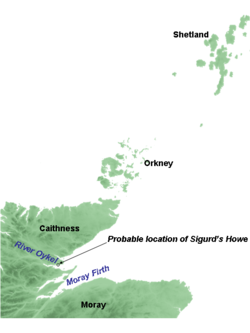
Sigurd Eysteinsson, or Sigurd the Mighty (reigned c. 875–892[1]), was the second Earl of Orkney—a title bequeathed to Sigurd by his brother Rognvald Eysteinsson. A son of Eystein Glumra, Sigurd was a leader in the Viking conquest of what is now northern Scotland.
His death was said to have been caused by the severed head of Máel Brigte, whom Sigurd defeated in battle.[1] As he rode a horse with Máel Brigte's head attached to his saddle as a trophy, one of Máel Brigte's teeth grazed against Sigurd's leg. The wound became infected, later causing Sigurd's death.[2]
- ^ a b Ashley, pp. 440–441
- ^ Translations of the Orkneyinga saga (chapters 4 and 5), which relates the story, can be read online at Sacred texts and Northvegr Archived 2008-05-16 at the Wayback Machine.